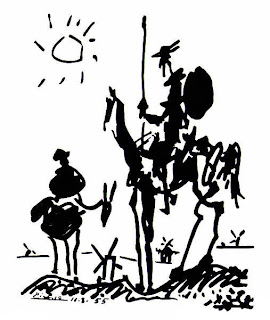Pablo Picasso painted Don Quixote in 1955, and it is one of his more well-known paintings. Don Quixote features the characters Don Quixote de la Mancha and his sidekick, Sancho Panza, which are characters from the story by Miguel de Cervantes. The novel, Don Quixote, tells the tale of a man named Alonso Quijano, who reads so any heroic novels that he sets out to become one himself under the name Don Quixote. Alonso appoints a simple farmer, Sancho, to be his squire. The name, Don Quixote, means talented defender or gifted saviour.
Unlike his previous paintings, Picasso's Don Quixote seems like a simple black and white sketch. His previous paintings contained multiple color schemes and symbolism. However, Don Quixote seems to hold more power than the rest. The featured figures look deformed but dramatic. Picasso grasps the fatigue and weariness that the reader feels in Don Quixote. In addition, it seems that the figures in Don Quixote were changed many times before final completion. Don Quixote, on the right of the painting, has a thin neck that connects his head to his rather large body. Compared to Panza, who sits on the left, Don Quixote looks ragged and malnourished. Nonetheless, Picasso captures his audience's attention in Don Quixote with an overall attractiveness and a "bright humor."
A link for the novel, Don Quixote, is below if you would liked to read a summary of the story Picasso based this painting on.
Source
Don Quixote
Don Quixote - Novel
1








The famous drawing was accidentally found several years ago. Art critics think that it's the original Don Quixote sketch which was painted by Picaso for a French magazine in 1955. It's written there. http://cubismsite.com/don-quixote-pablo-picasso/
ReplyDelete